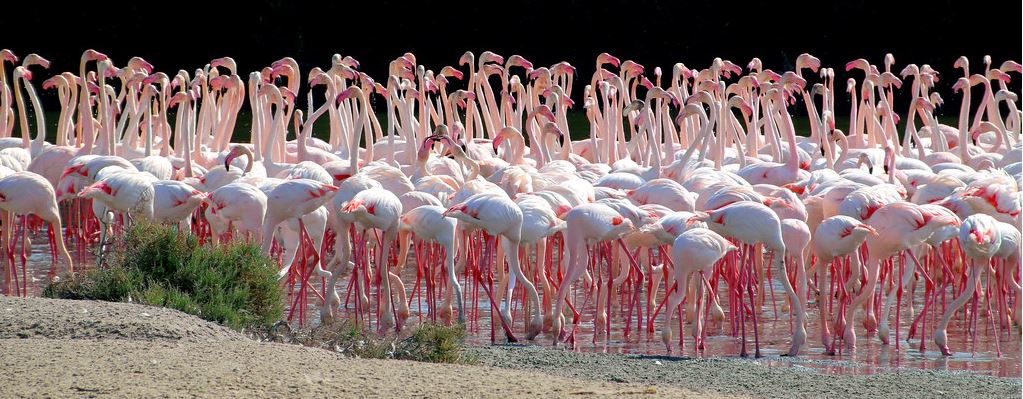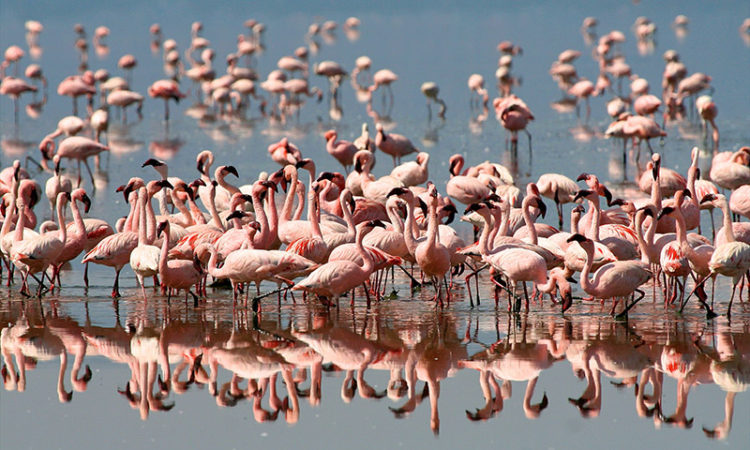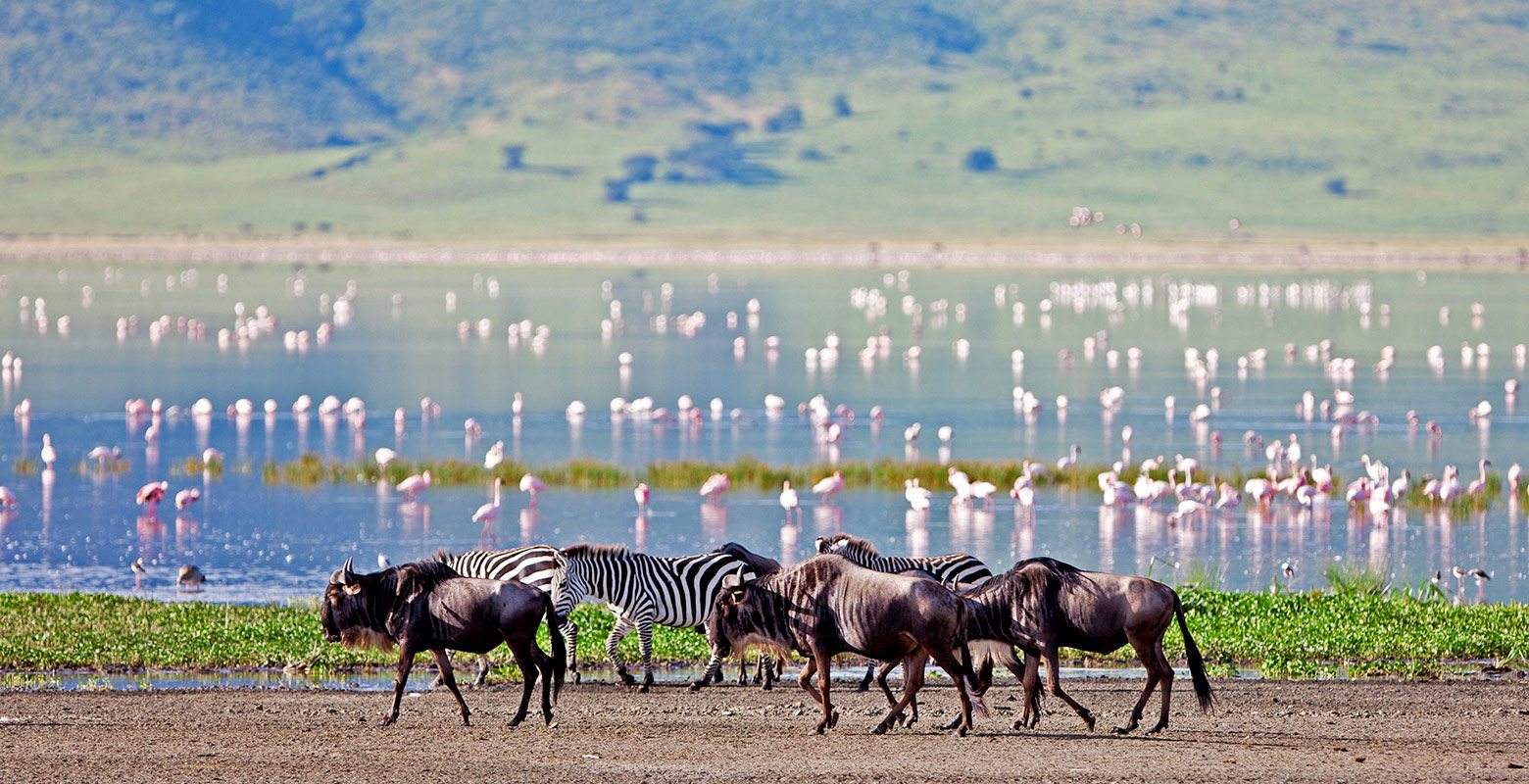Ngorongoro Crater flamingos are one of the most beautiful things to see in Ngorongoro Crater whilst on Ngorongoro Crater safaris. The flamingos are Lesser Flamingos scientifically known as Phoeniconaias Minor. Flamingos dwell in salty shallow lakes. In Ngorongoro Crater, the Ngorongoro Crater flamingos are found in the Lake Magadi which is a salty lake that attracts large flocks of flamingos that travelers can visit while on their Ngorongoro Crater safari drive.

The flamingos, and generally flamingos, feed on dead algae usually found in the salty lakes they inhabit. The lesser flamingos in the Crater are one of the flamingo species in Africa. The highest population of lesser flamingos are found in Lake Nakuru and Lake Naivasha in Kenya. In Tanzania, large flocks of flamingos are found in Lake Manyara found in Lake Manyara National Park, as well as Lake Magadi in the Crater.
There are 4 species of flamingos in the world, with 2 species of flamingos found in Africa that is the Greater Flamingos and Lesser Flamingos. The difference between the Greater Flamingos and the Lesser Flamingos is the size that they have. The Greater Flamingos are bigger than the Lesser Flamingos, and taller with the Greater Flamingos being 150cm tall when standing upright weighing to up to 4kgs.

The Ngorongoro Crater Tanzania inhabits the Lesser Flamingos. The flamingos are smaller in size, leaving in large groups of over 1000 individuals. Flamingos in the Crater are therefore very social, living in flocks. It is actually rare to see flamingos solo.
The flamingos are attracted by the shallow alkaline Lake Magadi found in the very middle of the Ngorongoro Crater. Lake Magadi derives her name from the local Masai language with the word Magadi literally translating to salty. The flamingos not only inhabit shallow lakes but also wetlands, lagoons and wetlands. Apart from dead algae, flamingos in the Crater also feed on crustaceans, brine shrimp, as well as plankton. These Ngorongoro Crater flamingos have specialized bills which filter out and separate waste from food whilst feeding.
Flamingos feed in a unique way, tilting their heads upside down, a sight that you would love to see while on Tanzania safaris visiting the Crater. The algae that they feed on grows in alkaline Lake Magadi which most a times turns pink when the flamingos feed on them, thereby turning the flamingos pink as well.
The breeding season of flamingos, in this case Ngorongoro Crater flamingos, starts from the month of October to December with the flamingos starting to lay out their nests. After building nests, flamingos lay one egg, which is incubated for 28 days not only by the female flamingo but also male flamingo. When hatched, the little hatched flamingo which is grey in color feed on their eggshell while the adults feed on the milky juice. Feeding the little chicks is done by both male and female flamingos, feeding them with a milky liquid. It takes the chicks a period of only about 1 week before it leaves the nest and joins the crèche. A crèche is a group of thousands of chicks looked after by a selected few adult flamingos. This while process is one of the most beautiful and unique characters of flamingos in the entire world.
As earlier mentioned, it is not only on Ngorongoro Crater that there are flamingos in Tanzania. Flamingos are also found in the alkaline lakes of Lake Manyara in Lake Manyara National Park, Lake Natron as well as Lake Magadi found inside the world famous Ngorongoro Crater Tanzania.
It is not only the flamingos that the Ngorongoro Crater inhabits. The Ngorongoro Conservation Area inhabits well over 450 bird species, which travelers can see while on various activities in Ngorongoro Conservation Area. Other birds in Ngorongoro Crater that travelers can see apart from the flamingos include the Secretary Bird, Hamerkop, Gray Heron, Great White Pelican, Long-Tailed Lapwing, and Speke’s Weaver, among so many others.

With the Ngorongoro Crater flamingos, along with other birds in Ngorongoro Crater recorded to be more than 450 bird species, have made the Crater one of the best birding destinations in Tanzania. Birding in Tanzania can best be done here, to see not only the flamingos but so many other bird species, as well as appreciate the other attractions in Ngorongoro Conservation Area.
Other attractions in Ngorongoro Crater Tanzania include wildlife like the Ngorongoro Crater big 5 animals, landscapes, scenery, culture, among so many others.
Interested to see the Ngorongoro Crater flamingos among other attractions in Ngorongoro Carter? Get in touch with a reputable tour operator to help you pitch together an amazing Tanzania safari, especially an amazing birding safari to the Ngorongoro Crater.


